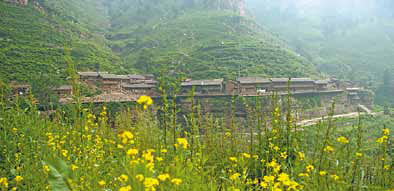Hope flickers in nearly deserted villages
Updated: 2013-08-15 00:04
By Chen Liang (China Daily)
|
||||||||
There are a few villages scattered along the road within Mount Luya National Forest Park in Ningwu county, Shanxi province.
The settlements of flat houses typical in the region usually feature black-tiled roofs and a courtyard enclosed by walls or wooden fences — a beautiful sight indeed.
 |
|
"Hanging Village" is a secluded hamlet in Mount Luya National Forest Park.[Photos by Wei Xiaohao /China Daily] |
But, many of the villages are deserted, with most of the houses locked, windows broken or roofs overgrown with weeds. From the looks of it, not many people are living in these valleys of the Guancen Mountains.
My local friend told me that's because traditional village schools, which were often short of teachers and facilities, have been dissolved in the past few years. These students are attracted to bigger and better primary schools in townships or county towns.
"As children left, so did their families," he says. "Now, except in the mushroom-picking season in the summer, you can hardly see young people in these villages."
It is true. Other than construction workers from Dongzhai township outside the park, we did not meet any young people even at "Hanging Village", a secluded ancient hamlet that has been developed into one of the major tourist attractions in the park.
The village, with about 20 families, sits on the top of a sheer precipice at an elevation of 2,300 meters above sea level. Flat houses with tiled roofs and traditional wooden structure stretch in a horizontal line on the cliff for more than 500 meters about 30 meters from the valley.
Leaning against the sunny slopes and overshadowed by the higher cliffs, the village looks as if it is hanging in the middle of a rock.
A well-paved stone path leads visitors from the bottom of the valley to the village entrance. The lane, zigzagging on the cliff, passes a water tank and a tiny mill with a millstone.
Ascending the stone steps through the entrance, you can reach the terrace in front of the houses that overlooks the valley embraced by lush coniferous forests. A river runs through the bottom of the valley. On the shady slope are orchards of various kinds of fruit trees, such as apple, pear and almond. Roses and wild flowers flourish at the periphery of the orchards.
The view is breathtaking, which can easily trigger a traveler's longing to sit down and have a cup of tea.
But such hospitality is still unavailable at the village. Maybe it is because the residents are all seniors, who lack the vision and ability to serve the visitors.
Tending several pigs and a flock of chickens remain the core activity for couple Bai Cunde and Wang Xiancun at the village.
They have nearly half a hectare of farmland on nearby slopes, on which they plant only yams.
"In the mountains, winter is long and cold, and you can't make a living just by farming," says Wang, the 59-year-old wife. "Besides, boars are common and often bully us (damaging the crop)."
Their son left for greener pastures in the cities, with his wife and children. At peak, there were 140 people living in the village, whose ancestors hid in the mountains to escape wars and natural disasters. Now there are only 30, Wang says.
Tourism hasn't slowed down the village's decline yet.
"Girls from the outside used to like moving to our village after marriages because harvests from forests and our farmland could make ends meet," Wang says.
"Now it's the opposite."
But things might change again. My friend and I spot a newly built guesthouse with a compound near the hamlet. Renovation is underway.
Sun Ruisheng contributed to the story.

 'Despicable' minions upset Depp's 'Lone Ranger' at box office
'Despicable' minions upset Depp's 'Lone Ranger' at box office
 'Taken 2' grabs movie box office crown
'Taken 2' grabs movie box office crown
 Rihanna's 'Diamonds' tops UK pop chart
Rihanna's 'Diamonds' tops UK pop chart
 Fans get look at vintage Rolling Stones
Fans get look at vintage Rolling Stones
 Celebrities attend Power of Women event
Celebrities attend Power of Women event
 Ang Lee breaks 'every rule' to make unlikely new Life of Pi film
Ang Lee breaks 'every rule' to make unlikely new Life of Pi film
 Rihanna almost thrown out of nightclub
Rihanna almost thrown out of nightclub
 'Dark Knight' wins weekend box office
'Dark Knight' wins weekend box office
Most Viewed
Editor's Picks

|

|

|

|

|

|
Today's Top News
China will overtake US as world's No 1 consumer
US asks China's help on DPRK issues
Movie tax flack is settled
Gold rises on physical buying from Asia
Millionaires hold dimmer view: Survey
Manning 'sorry' for US secrets breach
China to probe foreign automakers
Snowden case not to affect US-Russia talks
US Weekly

|

|




